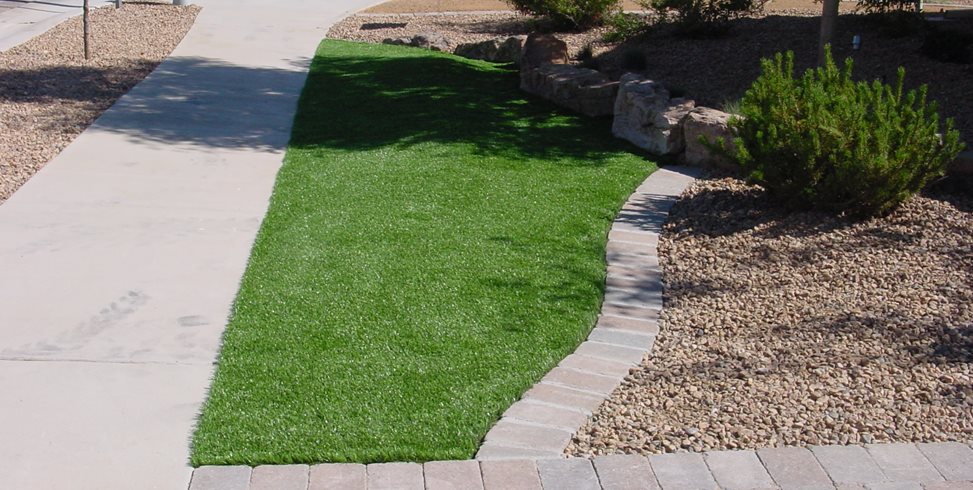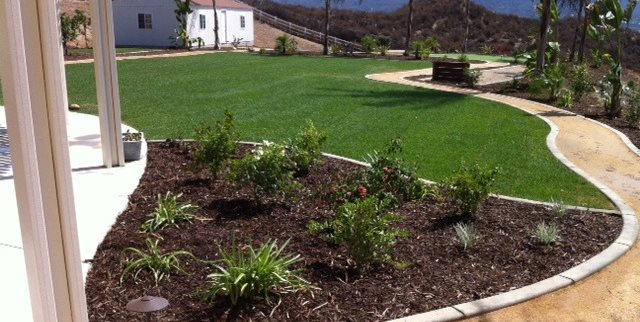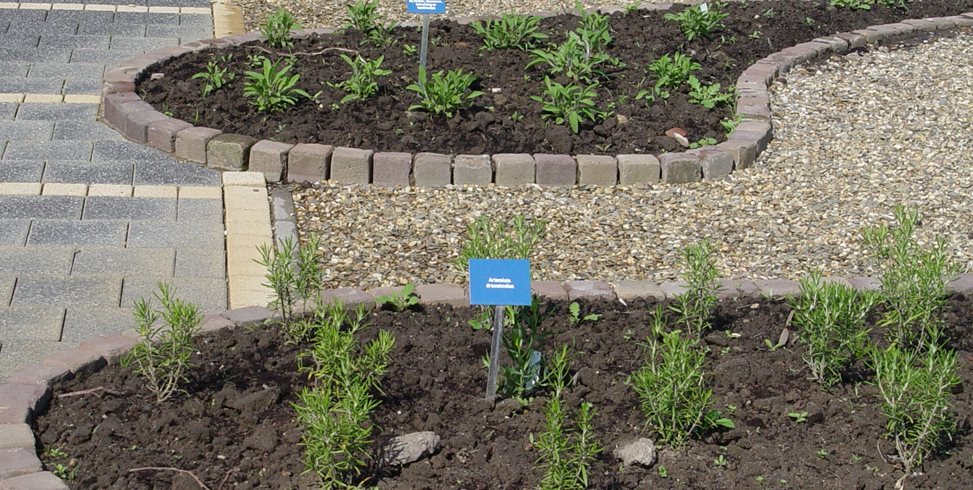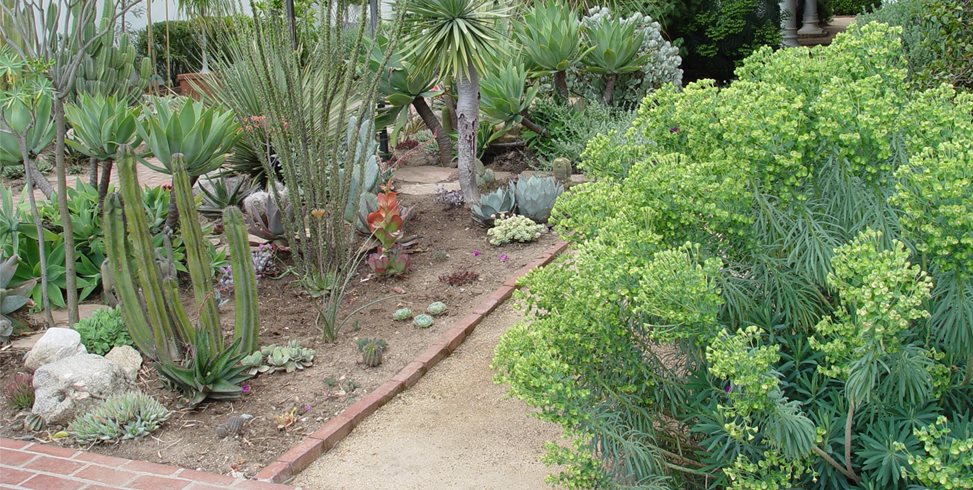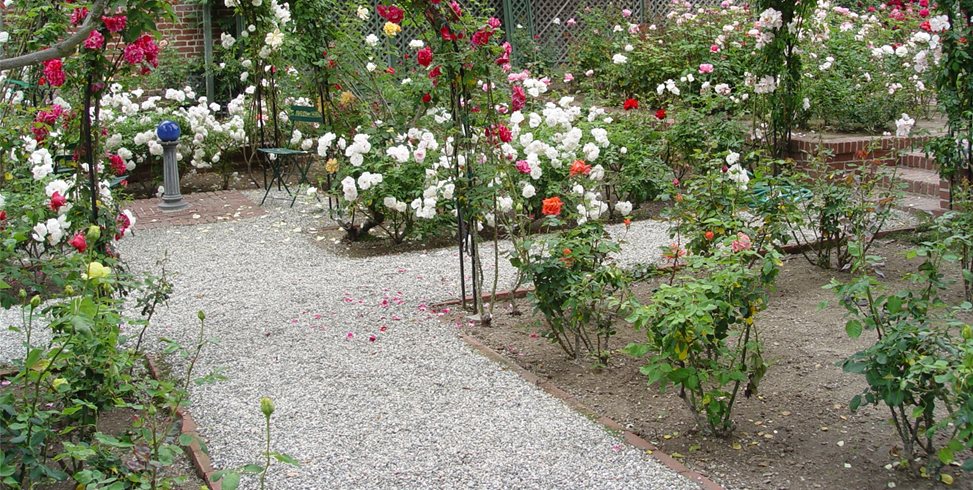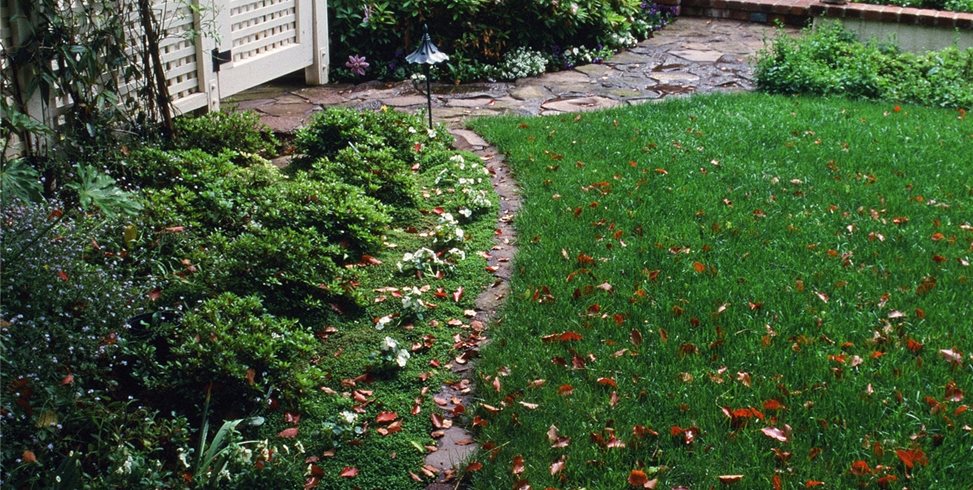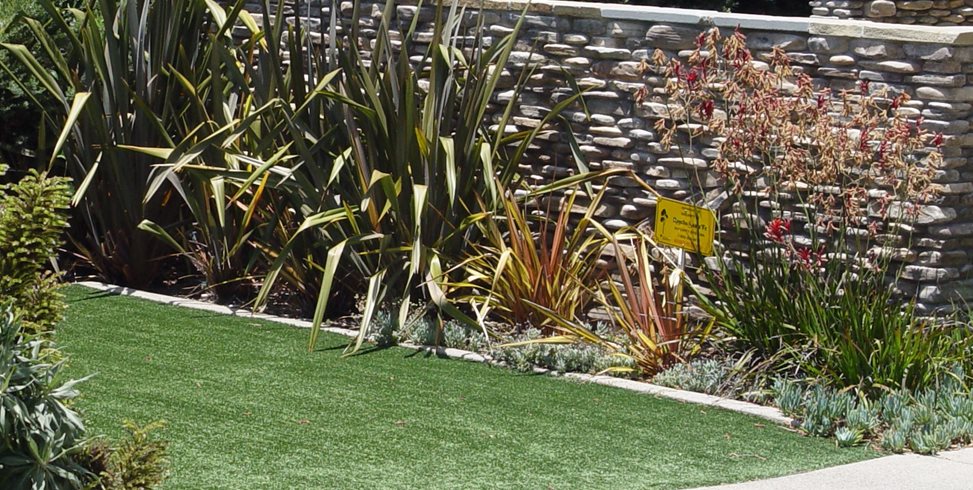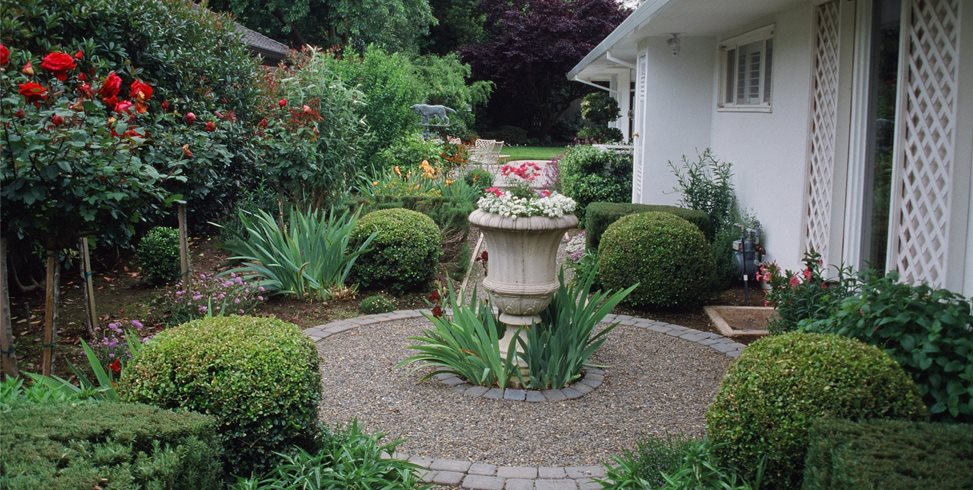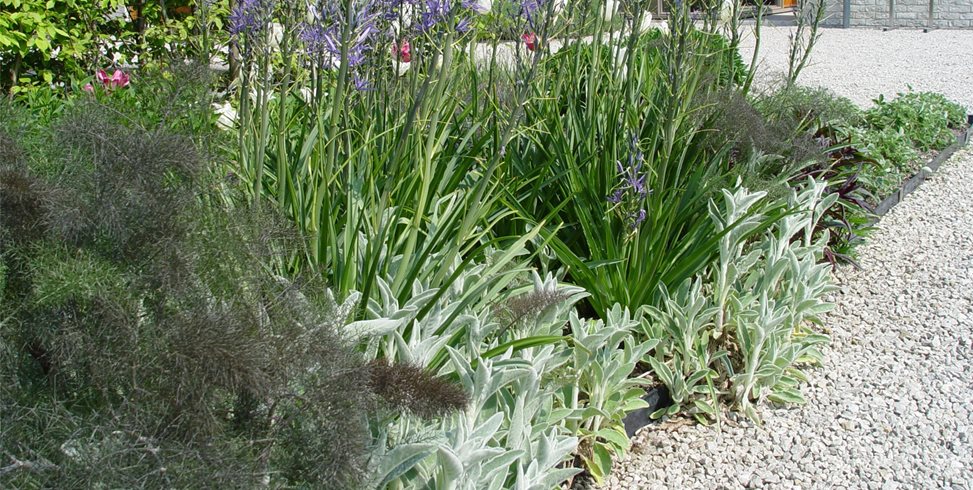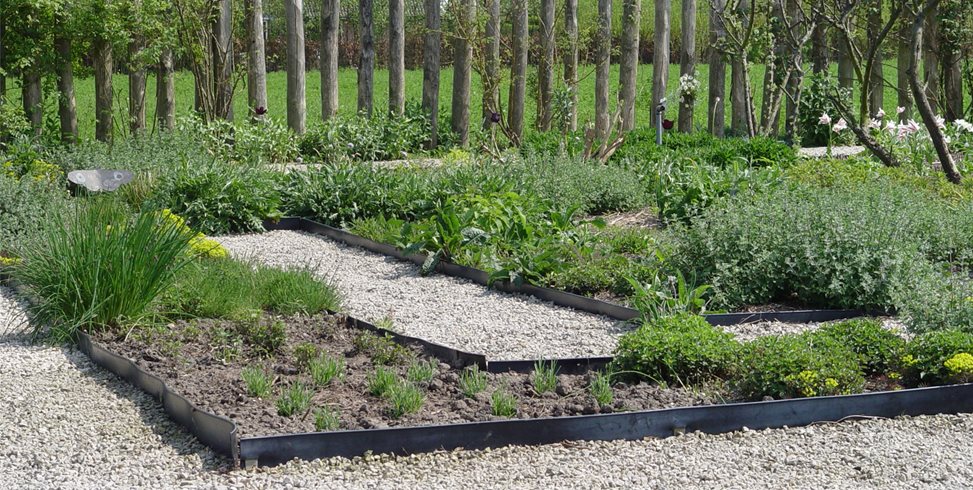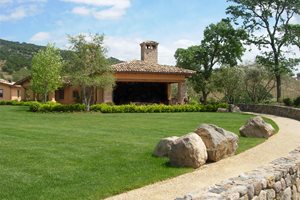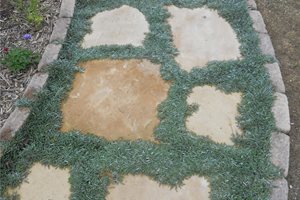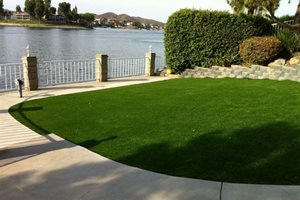Mow Strips for Edging Your Yard
A comparison of available lawn and garden edging materialsIn landscape design vernacular, edging presents a transition zone. Here the treatment of the ground plain or "floor" of the landscape changes from one material to another. The most frequent of these changes is from lawn to adjacent planter. In the past a spade cut edge was standard, but today that's considered high maintenance and unsuitable for a modern yard. Now the divider can be made of a variety of materials, with different longevity and cost. While cost is often the bottom line, there are two practical issues that govern the best choice for your edging: lawn maintenance and curves.
TURFEdging for lawn bears a certain requirement related to turf grass maintenance. A lawn mower must be able to overhang the edging a few inches for the blade to cut all the grass cleanly. Therefore edging should be low enough to allow the lawn mower to glide past easily. Edging that is too high may still be used, but it excludes edging machines that create a clean, knife edge to the turf.
CURVESComponents of a landscape can be laid out in graceful flowing curves. These curves are created by the constraints of bed depths and setbacks as well as the most efficient alignment for irrigation heads. Edging must conform to these curves, which may often bear diminishing radii. This demands an edging material that can conform to the unique curves created by your designer. Those edgings that come only with pre-established curves require the designer to design this radius into the project in order to match the edging product. For a quality landscape this may prove to be the tail wagging the dog.
Edging Comparison Chart
Use this chart to compare 16 different types of landscape edging. Compare attributes such as cost, visibility, curve options and more. This tool will help you select the right edging for your garden.
1. The Concrete Mow Strip
Poured concrete - This is the industry standard for lawn edging. It is formed up, then concrete is poured in place. The high cost of this option is largely due to labor building the forms which average about 8" apart. However, this provides many options for your design to turn it into more attractive edge by:
- Tinting the concrete with earth tones that blend into the garden far better than the ordinary gray.
- Imprinting a texture into the concrete to match other existing imprinted paving.
- Pour concrete with special aggregates that allow the contractor to create an exposed-aggregate surface.
- Applying ceramic, brick veneers or stone tile to the top of a concrete strip as an extension of other built elements in the landscape.
- Pro Tip: Since the cost of a mow strip is in the labor to build forms, then consider widening it to 12 or even 14 inches. This is enough to turn the mow strip into a convenient paved pathway to access all areas around the lawn. For families it can double as a continuous surface for toys, skates and bikes.
Extruded concrete mow strip- This newer option is also known as continuous- curb. It reduces construction cost without sacrificing the elegant look of a poured in place mow strip. No forms are required. A machine turns wet concrete into a compacted extrusion, or in simple terms, it is fed concrete as it moves down the prepared edge line, leaving behind a compacted ribbon of wet concrete. The concrete can be pre-tinted, and some contractors offer a wide range of faux surface finishes that mimic the look of stone and other high end materials.
- Pro Tip: Extruded concrete is a great way to make a curb where two levels of ground meet. For example, if the lawn is a few inches higher than the adjacent pavement, an extruded 8" high curb can be installed like a mini-retaining wall to take up the grade and prevent the lawn draining water and silt onto the pavement.
2. Masonry Unit Edging
A wide range of masonry units are available for creating attractive edges in a landscape. They are attractive and offer a more affordable alternative to poured concrete. The weakness of this system is climates where the ground freezes, or where the soil is highly plastic such as dense clay. The heaving of soil from spring freeze-thaw can easily move the units out of place. Expanding clays during the rainy season can also cause dislocation. Regular battering by lawn care equipment, or very aggressively rooted turf grass can, over time alter the placement of the units. Manufacturers have tried various means to resolve these issues such as:
- Very heavy units are less likely to be moved out of place.
- A very deep unit allows the bottom half to be buried underground for anchorage.
- Units designed to interlock prevents the unions from moving, but it is typically vertical or horizontal stabilization, but rarely both.
- Units with special anchorage hardware that allows each one to be staked firmly into place.
3. Strip Edging
The most affordable edging is also the most invisible, making this appealing for those who do not like the look of highly visible mow strips. The material is long strips of UV resistant plastic, poly resins, metal and wood staked into place at regular intervals.
Quarter inch redwood "benderboard" was the first of these, long before the advent of concrete mow strips or modern plastics. Over time the thin redwood boards and their anchor stakes would break down from weathering and the continual battering of lawn maintenance equipment. Plastic and resin was designed to solve this problem and they are quite effective, but in very hot dry climates with high UV levels they can break down or become brittle. Metal, typically aluminum tends to be more long lived, but material cost is high.
Strip edging is useful for controlling the edges of gravel fields and pathways where you need a barrier at least three inches above grade. Without edging, gravel tends to travel over time, particularly if it is rounded such as river run or pea gravel. The edges feather out to destroy the original crisp line. The downside is caused by gravel building up against a strip edge, which is not strong enough to bear this weight. Over time the edging will lean and anchor stakes become bent or uprooted to destabilize the edge.
- Pro Tip: The type of mulch you use in your landscaped beds will have an impact on whether or not you need to use edging. If your landscaped beds are mulched with shredded wood or wood chips, the lawn will grow into it quickly and you’ll need to redefine the edge one to two times per year so the grass doesn’t take over. On the flip side, if you have landscaping fabric, rubber mulch, gravel or other nonbiodegradable mulch, you’ll need some kind of permanent edging to keep these materials out of your lawn.
4. Stone Edging
Stone is a classic, high-end choice for edging and is the most expensive option available. However, stone has uneven edges and so you will usually need to string-trim along the edges of a stone border. You’ll also want to make sure you mortar your stone border in place so no lawn can creep through the barrier.
5. No Edging
Many people prefer the natural, unobtrusive look of having no edging at all. However the problem with having no edging is that it is higher maintenance. Mark Paine of Sposato Landscape in Milton, DE says, “We manually edge with a square point spade at a lot of our jobs. We move quickly, and it’s a very clean look.”

 Backyards
Backyards
 Front Yards
Front Yards
